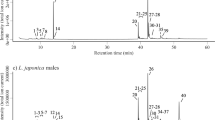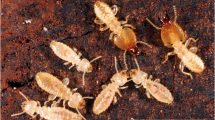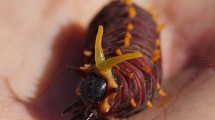Abstract
The chemical composition of the defensive secretions of 52 species from 15 genera of the tenebrionid subtribe Stizopina was analyzed. The secretions of all species contained 1,4-benzoquinones, 1-alkenes, and monoterpene hydrocarbons, only one species was lacking the latter. Methyl- and ethyl-1,4-benzoquinone were ubiquitous, mostly accompanied by smaller amounts of 1,4-benzoquinone as well as isopropyl- and propyl-1,4-benzoquinone. 1-Alkenes were dominated by 1-undecene with varying admixtures of other 1-alkenes. The monoterpene hydrocarbons always consisted of a mixture of α-pinene, camphene, β-pinene and limonene, but also p-cymene, α-terpinene or α-phellandrene were found in some species. Furthermore, some species synthesized additional compounds such as phenols, ketones, 2,5-dihydroxy-6-methylbenzoate, 2-hydroxy-4-methoxyacetophenone and naphthoquinones. Bioassays showed that the defensive secretion co-functioned as an aggregation pheromone in the subtribe Stizopina. All nine tested species from six genera were attracted to defensive secretion of Stizopina species, but they did not distinguish between defensive secretions of different Stizopina species. This lack of discrimination might be the initial step for the formation of interspecific aggregations and the evolution of cleptoparasitism within the Stizopina.

Similar content being viewed by others
References
Attygalle AB, Blankespoor CL, Meinwald J, Eisner T (1991) Defensive secretion of Tenebrio molitor (Coleoptera: Tenebrionidae). J Chem Ecol 17:805–810
Blum MS (1981) Chemical defenses of Arthropods. Academic Press, New York
Blum MS (1996) Semiochemical parsimony in the Arthropoda. Annu Rev Entomol 41:353–374
Brown WV, Doyen JT, Moore BP, Lawrence JF (1992) Chemical composition and taxonomic significance of defensive secretions of some Australian Tenebrionidae (Coleoptera). J Aust Ent Soc 31:79–89
Dettner K (1993) Dabbing and shooting of benzo- and naphthoquinone secretions: defensive stratigies of bark-inhabiting aleocharine (Col.: Staphylinidae) and tenebrionid (Col.: Tenebrionidae) beetle larvae. J Chem Ecol 19:1337–1354
Francis GW, Veland K (1981) Alkylthiolation for the determination of double-bond position in linear alkenes. J Chromatogr 219:379–384
Francke W, Dettner K (2005) Chemical signalling in beetles. Top Curr Chem 240:85–166
Geiselhardt S, Szepat T, Rasa OAE, Peschke K (2006a) Defensive secretion components of the host Parastizopus armaticeps as kairomones for the cleptoparasite Eremostibes opacus. J Chem Ecol 32:767–778
Geiselhardt SF, Geiselhardt S, Peschke K (2006b) Chemical mimicry of cuticular hydrocarbons—how does Eremostibes opacus gain access to the breeding burrows of its host Parastizopus armaticeps (Coleoptera, Tenebrionidae)? Chemoecology 16:59–68
Gnanasunderam C, Young H, Hutchins RFN (1981) Defensive secretions of New Zealand tenebrionids: I. Presence of monoterpene hydrocarbons in the genus Artystona (Coleoptera, Tenebrionidae). J Chem Ecol 7:889–894
Gnanasunderam C, Young H, Hutchins R (1985) Defensive secretions of New Zealand tenebrionids: V. Presence of methyl ketones in Uloma tenebrionoides (Coleoptera: Tenebrionidae). J Chem Ecol 11:465–472
Howard RW (1987) Chemosystematic studies of the Triboliini (Coleoptera: Tenebrionidae): phylogenetic interferences from the defensive chemicals of eight Tribolium spp., Palorus ratzeburgi (Wissmann), and Latheticus oryzae Waterhouse. Ann Entomol Soc Am 80:398–405
Kaufmann T (1966) Observation on some factors which influence aggregation by Blaps sulcata (Coleoptera: Tenebrionidae) in Israel. Ann Entomol Soc Am 59:660–664
Koch C (1963) The Tenebrionidae of Southern Africa XXIX. Luebbertia plana gen.et spec. nov., with a dichotomic analysis of Stizopina (Opatrini). Scient Pap Namib Des Res Station 18
Lloyd HA, Evans SL, Khan AH, Tschinkel WR, Blum MS (1978) 8-Hydroxyisocoumarin and 3,4-dihydro-8-hydroxyisocoumarin in the defensive secretion of the tenebrionid beetle, Apsena pubescens. Insect Biochem 8:333–336
Penrith ML (1984) Two new species of Stizopina (Coleoptera: Tenebrionidae: Opatrini) from Namaqualand, southern Africa, and the relationships between the psammophilous genera. Ann Transv Mus 33:353–363
Peschke K, Eisner T (1987) Defensive secretion of the tenebrionid beetle, Blaps mucronata: Physical and chemical determinants of effectiveness. J Comp Physiol A 161:377–388
Rasa OAE (1990) Evidence for subsociality and division of labor in a desert tenebrionid beetle Parastizopus armaticeps Peringuey. Naturwissenschaften 77:591–592
Rasa OAE (1994) Parabiosis and its proximate mechanisms in four Kalahari desert tenebrionid beetles. Ethology 98:137–148
Rasa OAE (1996) Interspecific association in desert tenebrionid beetles: a cleptoparasite does not affect the host’s reproductive success, but that of its offspring. Naturwissenschaften 83:575–577
Rasa OAE, Endrödy-Younga S (1997) Intergeneric associations of stizopinid tenebrionids relative to their geographical distribution (Coleoptera: Tenebrionidae: Opatrini: Stizopina). Afr Entomol 5:231–239
Tannert W, Hien BC (1973) Nachweis und Funktion eines “Versammlungsduftstoffes” und eines “Alarmduftstoffes” bei Blaps mucronata Latr., 1804 (Coleopt.-Tenebrionidae). Biol Zbl 92:601–612
Tschinkel WR (1969) Phenols and quinones from the defensive secretions of the tenebrionid beetle, Zophobas rugipes. J Insect Physiol 15:191–200
Tschinkel WR (1972) 6-Alkyl-1,4-naphthoquinones from the defensive secretion of the tenebrionid beetle, Argoporis alutacea. J Insect Physiol 18:711–722
Tschinkel WR (1975a) A comparative study of the chemical defensive system of tenebrionid beetles—chemistry of the secretions. J Comp Physiol 21:753–783
Tschinkel WR (1975b) Unusual occurrence of aldehydes and ketones in the defensive secretion of the tenebrionid beetle, Eleodes beameri. J Insect Physiol 21:659–671
Wertheim B, van Baalen E-JA, Dicke M, Vet LEM (2005) Pheromone-mediated aggregation in nonsocial arthropods: an evolutionary ecological perspective. Annu Rev Entomol 50:321–346
Acknowledgments
We are grateful to Stefanie Geiselhardt and Vanessa Zabka for their field assistance, and the Ministry of Environment and Tourism (Republic of Namibia), the Northern Cape Nature Conservation Service and the Western Cape Nature Conservation Board (Republic of South Africa) for the granting of the collection permits. This work was supported by the Deutsche Forschungsgemeinschaft (Pe 231/13-1).
Author information
Authors and Affiliations
Corresponding author
Rights and permissions
About this article
Cite this article
Geiselhardt, S., Schmitt, T. & Peschke, K. Chemical composition and pheromonal function of the defensive secretions in the subtribe Stizopina (Coleptera, Tenebrionidae, Opatrini). Chemoecology 19, 1–6 (2009). https://doi.org/10.1007/s00049-008-0001-7
Received:
Accepted:
Published:
Issue Date:
DOI: https://doi.org/10.1007/s00049-008-0001-7




